1997-4-16 last update, 1997-2-1 first day
Robert Jasiek, jasiek@snafu.de
Copyright: All rights of the author are preserved according to the
international law.
Examples 7
Introduction
This page gives game end examples. Also
note the classification, where rule sets belonging
to the classes can found, and conventions.
- First game phases are illustrated as to their
characteristic move types.
- Then play under different rule classes incl.
scoring is shown. Classes with very different or too few rule sets are
omitted in this overview. Slight deviations within a class are to be expected.
- Finally examples treat counting methods.
Game Phases
For a simple game phase structure see phases
of game ends. The following examples spare game stop and game end diagrams.
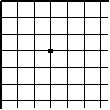
outset; here a 7x7 board

setup; here black starts with three instead of one board plays
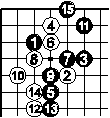
alternating competition

neutral points and defensive points inside territory
- 1, 2, 4, 5, 7, 8, 9 are neutral points.
- 3, 6 are defensive points inside territory.
- A is removed from the board as soon as 6 is played
- B still remains on the board. Removal might happen later.
- Some rule sets do not apply alternation for neutral points occupation
in the confirmation phase. But still defending inside is left for the defending
player.
- Some rule sets invoke elimination of ko threats if necessary. This
is not shown in this example.
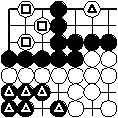
optional game stop and removal due to agreement or rules in
optional confirmation phase
- First two successive passes stop the game (if not done before). Then
a confirmation phase follows. Both are optional and not used in all rule
sets.
- Possibly both players may agree that all marked stones can be removed
and remove them.
- Life-death rules require all marked stones to be removed.
- Both players might agree on removing all triangled stones. With the
squared stones still on the board a removal of them by alternating play
might follow. This is a kind of resumption. Some rule sets then require
to restore the board, i. e. to put the triangled stones on the board again.

removal by alternating play and game end
- Starting from the position of the last example both players remove
all stones from the board that they can capture by alternating play.
- 6, 8, 10, 12, 14, 16, 17 are passes.
- The last two successive passes indicate that no player wants to alter
the board any longer. The game ends.

ancient encore
- With a stone rule set both players gain points by filling the board.
- Play naturally ends when all moves would harm oneself.

greedy ancient encore, B to play
- This is only possible with greedy ancient rules.
- Kos become dissolved.
- After B[da] b is prohibited due to repetition, c would cause capture
at e, so B[dap]. After B[dapc] both b and d would repeat. B[dapcpe]# captures
all. Then B must lose a few more stones, but finally W can occupy all the
points. In the end W occupies 37 grid points to B's 15.
Rule Classes
Stone Rules
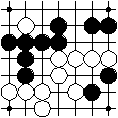
actual position

27, 28 = pass; moves to game end
- B occupies 22 grid points with stones, W 23.
- Only stones on the board are scored. W wins by 1 point.
Simple Area Rules

actual position
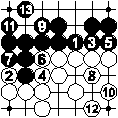
14, 15 = pass; moves to game end
- The game can end as soon as connected empty grid points are monochromely
surrounded.
- B has 16 stones on the board and 8 surrounded empty grid points. His
score is 24 points.
- W has 16 stones on the board and 9 surrounded empty grid points. His
score is 25 points
- W wins by 1 point.
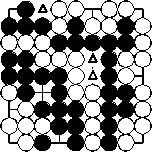
scoring position
- The marked and shared points need not be counted.
- B has 34 stones and 3 empty points, thus 37 points.
- W has 35 + 6 = 41 points.
- W wins by 4 points.
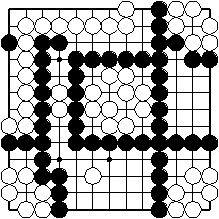
game end position
- It was a mistake to end the game. Scoring, however, is no problem.
- B has 49 stones and 13 monochromely surrounded points, altogether 62
points.
- W has 46 plus 8, i. e. 54 points.
- B wins by 8 points.
Agreement Area Rules

actual position
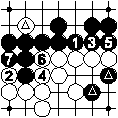
8, 9 = pass; moves to game stop

removals due to mutual agreement; 10, 11 = pass; moves to game
end
- The first two successive passes stop the game.
- Then in the confirmation phase the players may agree about removals.
They shall agree to remove the marked stones.
- Finally two successive passes end all removals and the game.
- In case of disagreement alternate play proceeds as with simple area
rules.
- At the end after agreement B has 13 stones plus 11 grid points, i.
e. 24 points.
- W has 13 + 12 = 25 points.
- W wins by 1 point.

scoring position
- The marked and shared points need not be counted.
- B has 34 stones and 3 empty points, thus 37 points.
- W has 35 + 6 = 41 points.
- W wins by 4 points.

game end position
- It was a mistake to end the game. Scoring, however, is no problem.
- B has 49 stones and 13 monochromely surrounded points, altogether 62
points.
- W has 46 plus 8, i. e. 54 points.
- B wins by 8 points.
Life-Death Territory

actual position

alternate play; 3, 4 = pass; play to game stop

filling of neutral points

removals of dead stones according to rules

final scoring position
- No prisoners shall have occured til the actual position.
- The two successive passes 3, 4 stop the game.
- Neutral points and defensive moves inside territory could also have
been made before stop. Some rule sets require this.
- Since not done before, neutral points and defensive moves (here are
none) must be filled at the beginning of a confirmation phase.
- The triangled stones are these filling moves. Neutral points can be
filled with an arbitrary colour.
- (Japanese 1989: ) Now agreement by both players "ends" the
game.
- Then in another confirmation phase (in Japanese 1989 part of "determination
of result") all stones (here squared) that are termed dead by the
rules are required to be removed from the board and added to the prisoners.
- B has 11 surrounded empty points and 1 prisoners, giving 12.
- W owns 12 surrounded empty points and 2 prisoners, the sum being 14.
- W wins by 2 points.
- Summarized reasonings of Japanese 1989 for removals of dead stones:
- Any hypothetical play of alternating moves leads to capture of the
squared stones.
- One example move-sequence is that of play under simple area rules.
- Furthermore, no capture enables new uncapturable stones to exist.
- Summarized reasonings of Japanese 1989 for scoring position:
- All strings are alive, because none can be captured.
- All empty board points are eye points, because they are surrounded
by living stones of only one colour.
- No dame exists, thus no seki.
- All eye points are surrounded by living stones not in seki and are
thereby territory.
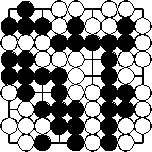
scoring position
- The rules see life in three sekis on the board.
- Empty grid points of sekis are no territory.
- With no prior prisoners the game is a tie.
- Summarized reasonings of Japanese 1989:
- The W string in the lower left is alive, because it cannot be captured.
The reasoning is as follows: An attempt of capture requires a B ko capture.
This is answered by a W ko capture in the other ko. Before a B recapture
B must pass for the proper ko. A proper B pass is answered by a W pass
for the other ko. Then B may capture a ko and W capture the other. This
process can be repeated but never enables capture of the lower left W string.
- The same argument holds for the B string adjacent to both kos.
- The B ko stone can be captured.
- Capture of the B ko stone does not enable B to play a stone that cannot
be captured. As described above new stones are created. But they can be
captured. This is true for an infinite sequence.
- Thus the B ko stone is dead.
- Similarly the W ko stone is dead.
- The W string and the B string in the middle of the board cannot be
captured, because an attempt would result in capture of the opponent's
string. Thus both are alive.
- Similarly all remaining strings are alive.
- The lower left corner point, the empty board point surrounded by the
big B string in the lower left corner, the empty board point in the upper
left corner, the three empty board points on the right side, and the second
right of the upper side are all eye points, because they are surrounded
by living stones of only one colour.
- All other empty board points are dame.
- The four big strings in the lower left and the middle, and the two
left strings on the upper side possess dame and are therefore in seki.
- All the W stones on the right and upper sides are not seperated by
living B stones and thus considered together as a group of stones as to
the type of life.
- One of the strings of the group has dame, thus all stones of the group
are in seki.
- No empty board point is surrounded by living stones of one colour and
not in seki. Hence no territory exists. The game is a tie.

game end position
- It was a mistake to end the game. Scoring, however, is still possible.
- (Japanese 1989.) The rules say that the three small strings on the
left half of the board are dead. The only stones alive not in seki are
the W of the upper right corner. Therefore the rules conclude that only
there territory exists.
- W wins by 2 points.
- Summarized reasonings of Japanese 1989:
- The single B stone can be captured, because W plays above, B passes,
W captures.
- Capturing the single B stone does not enable a new stone to be played
that the opponent could not capture, because after capturing as above a
board play on the capturing point cannot exist and the other two involved
board points are occupied by living stones.
- For each of the two W small strings similar arguments can be retrieved.
- All other strings are alive. For each of these it can be shown that
it cannot be captured. This is comparatively easy, because two independent
eyes can be constructed for each after rather short hypothetical play.
- The four pairs of W strings surround empty points by stones of only
one player. The connected empty points on the right side are surrounded
by B stones only. All these empty points are called eye points.
- At the upper left part of the edges all empty points with a path along
empty points to the single B stone plus the point of the single B stone
itself are surrounded by the living big W string and therefore called eye
points of W.
- Similarly all empty and W points between the two big B strings are
eye points of B. (These form one connected region of board points.)
- All other empty points on the board are called dame.
- The two big B strings, the big W string, the center W strings, the
lower right W strings, and the upper one of the lower left W strings have
dame and are therefore called being in seki.
- The W string on the left of the lower edge cannot be disconnected by
B from the other W string near to it. So both are together in seki.
- The small B string on the right side cannot be disconnected from the
B string near to it by living W stones. So this is in seki, too.
- Only the two W strings in the upper right corner are considered alive
not in seki.
- The only eye points surrounded by stones that alive but not in seki
and thus territory are the two in the upper right corner.
- So W has two points of territory while B has none.
Counting Methods
Stone Counting

scoring position

counting position
- All B stones are put on the upper side, all W on the lower, resulting
in a nearly point-symmetrical formation.
- The marked stone violates symmetry and defines the winning margin:
1 point for W.
Point By Point Counting

scoring position
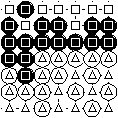
counting position
- First the B score is directly counted by scanning all squared points.
This gives 24 points.
- Then the same is done for the W score (25 triangles).
- W wins by 1 point.
Point By Point Half Counting

scoring position

counting position
- The B score is directly counted by scanning all squared points. This
gives 24 points.
- The board has 49 grid points of which none are shared. Half the board
is 24.5 points.
- B has 0.5 less than half the board. Thus B loses by 1 point.
- If a komi is 2.5, then the half komi is 1.25. The B points are compared
with half the board plus half komi, i.e. 24.5 + 1.25 = 25.75. B then has
1.75 points less. Thus B loses with 3.5 points. (Note: 1 + 2.5 = 3.5 in
full count.)

scoring position

counting position
- B's score consists of all squared points which are counted point by
point giving 37.
- The number of grid points of the board is 81, the number of shared
grid points (triangled) 3, the difference is 78, half of it is 39.
- B has 2 half count points less than W; W wins by 4 points.
Chinese Half Counting

scoring position
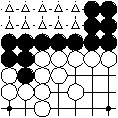
rearranged empty spaces of one colour

rearranged stones of one colour
- The B empty spaces are conveniently rearranged to multiples of 10.
B has 10 triangled empty spaces then. (To this point stones can be added
or taken away.)
- Another rearrangement gives a value for the then remaining B stones
on the board: 14.
- B has 24 points altogether.
- The board has 49 grid points of which none are shared. Half the board
is 24.5 points.
- B has 0.5 less than half the board. Thus B loses by 1 point.
- If a komi is 2.5, then the half komi is 1.25. The B points are compared
with half the board plus half komi, i.e. 24.5 + 1.25 = 25.75. B then has
1.75 points less. Thus B loses with 3.5 points. (Note: 1 + 2.5 = 3.5 in
full count.)
Japanese Territory Counting

scoring position
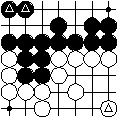
putting prisoners on board
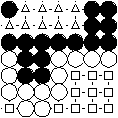
rearranged territories
- All prisoners (as far as possible) are put in the territories of their
colours.
- The remaining territories are conveniently rearranged.
- B has 9 triangled points of territory, W has 11 squared points.
- W wins by 2 points.

scoring and counting position
- Neither player has any point of territory that would need counting;
the game is a tie.
Fill-in Counting

scoring position
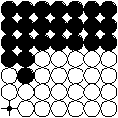
counting position; no komi
- Each side has exactly 24 stones.
- All stones are filled in the empty regions of their colours.
- The remaining single empty monochromely surrounded grid point is W's
winning space. W wins by 1 point.
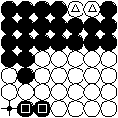
counting position; 4 komi
- Two W komi stones (triangled) represent the 4 komi. B cannot fill these
two grid points.
- The single empty grid point and the two B losing stones (squared) define
the W winning margin of 5 points.
- Note that all komi and losing stones count doubly, because each is
not filling an own grid point and simultaneously prevents an opponent's
stone from filling.
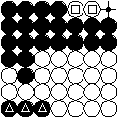
counting position; minus 6 komi
- Three B komi stones (triangled) represent the minus 6 komi.
- The empty space and the two squared W stones near to it show B's win
of 5 points.

scoring position

counting position; 8 komi
- At the scoring position both players have three stones left off the
board.
- To represent 8 komi W needs a fourth stone and uses the point a for
it.
- B is required to present W with 4 empty grid points for komi placement.
He has only 2 and thus also uses b and c.
- The by now 4 W stones off the board are put on b, c, and triangles
as komi stones.
- The 5 B stones become losing stones. The 3 squared are from the stones
left off the board, the other 2 (circle and a) come from b and c.
- W wins by 11 points.

scoring position

counting position
- B has 6 and W has 5 stones left.
- Three shared grid points, an odd number, are on the board.
- The shared grid points are equally filled as far as possible (triangles).
The empty space left on the board is the odd empty point a.
- Monochromely surrounded grid points are filled.
- B retains two losing stones; they become the squared stones. It is
impossible to put them together or near to an empty grid point. Still their
meaning is clear: W wins by 4 points.

















































